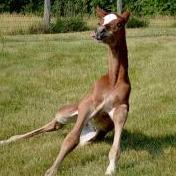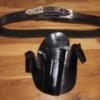All About Leather
Latigo & Harness Leathers are treated with waxes and oils to resist water and limit stretching. Garment leather is not just from cows, it includes deerskin, pigskin, goatskin, sheepskin, suede/splits, and other lightweight leathers. Upholstery leather is heavier weight and may require a commercial machine. Rawhide is not tanned, and has excellent properties for forming. It is not the leather your shoelaces are made from. Vegetable tanned leather is the only type of leather that will absorb water enough to stamp or carve.
696 topics in this forum
-
- 3 followers
- 1 reply
- 13.6k views
http://www.answers.com/topic/leather Leather, skin or hide of animals, cured by tanning to prevent decay and to impart flexibility and toughness. Prehistoric and primitive peoples preserved pelts with grease and smoke and used them chiefly for shoes, garments, coverings, tents, and containers. Today pelts are prepared for tanning by dehairing, usually with lime, followed by fleshing and cleaning. After tanning, leather is generally treated with fats to assure pliability. The practice of shaving leather to the required thickness was abandoned early in the 18th cent. after the invention of a machine that split the tanned leather into a flesh layer and a grain (hair-side) l…
 Last reply by Wizcrafts,
Last reply by Wizcrafts, -
According to the Tanner's Council of America, our industry uses hides from steer, cows, bulls, sheep, lamb, goat and kid, horses, goat, ass, mule, zebra, pig, hog, peccary and carpincho, land and water buffalo (not American Bison) and exotic and fancy feathers such as frog, ostrich, crocodile, lizard, snake, seal, shark, walrus, turtle, and camel to produce products. This council also clarifies a number of definitions that are commonly used in the leather industry. We gratefully acknowledge the Council's Dictionary of Leather Terminology, as well as the organization's publication, "Leather Facts," as we highlight some of the words we use daily in our business LEATHER …
Last reply by hotleatherworlds, -
- 0 replies
- 6.8k views
Courtesy Zack White Leather: "What Leather Should I Use for my project?" We get asked this question several times a day, and if you are new to the trade, it is a very legitimate question. There are so many different kinds and cuts of leather, it can be confusing. Let me try to give a few helpful hints. -First, always choose a vegetable tanned leather if you are making a sheath or holster. This is important because chrome salts in leather will tarnish metal. The good thing is that almost all natural vegtanned leather can be used, but it always good to ask if the leather contains any chrome… just to be on the safe side. -Next, are you going to dye the leath…
Last reply by RCZWL, -
- 0 replies
- 3.2k views
I need to store the deerskins that I have, as I try to determine how exactly to choose the additional deerskins I need for my next project, as no one here seems to know the exact answer to my question, asked in another thread. As I wait, I found a way to store the deerskins, that has not damaged the deerskins as yet. So I thought I would share it here for newbies in the field like me. Others might be using the same method as well, of course.. I need this way because I do not have space to hang them all up. I store my deerskins in large zip-lock bags, the ones I received clothes in, actually. I leave sufficient air inside to provide a buffer against the weight o…
 Last reply by SUP,
Last reply by SUP, -
- 1 reply
- 1.2k views
Hi All, I make custom sandals. I'm looking to source a replacement for Tandy's Denver Side (Military Green, Olive Green). It's only 3-4 oz so I double it up and sew it. Customers love this look but I can't source an equal. Please help. Thanks in advance. Matt Paisley Paisley Running Sandals
 Last reply by TomE,
Last reply by TomE, -
- 2 followers
- 7 replies
- 1.6k views
I’ve been searching the forums about mold on leather. It seems some people use Listerine in their casing water, I assume to prevent the mold from starting in the first place. Does it work? I’ll probably use an antique dye so I don’t think discoloration would be a problem. I’m thinking about doing a western scene which would take several days to tool. It would be stored damp, in a sealed bag, and in my fridge between sessions. Thank ye kindly.
Last reply by Mungo, -
- 1 follower
- 3 replies
- 658 views
Good Morning All, I have been making some wallets for awhile now learning techniques. I have gotten a few request for a traditional bifold. I have used the Buttero 3oz leather, but I feel like its a little bulky. I see that I can order it from Rocky Mountain in different options, do you guys recommend a certain weight for something like this ? Thank you!
 Last reply by Gridix,
Last reply by Gridix, -
- 0 replies
- 719 views
For equestrians, proper maintenance of gear is essential—not just for aesthetics, but also for safety, longevity, and the well-being of the horse. Whether you’re a trail rider, a competitive show jumper, or someone who simply enjoys a quiet ride through the countryside, ensuring that your tack is in top shape should always be a priority. One of the most effective ways to preserve your equipment is by using the right horse tack care products to clean, condition, and store your gear properly. Why Tack Care Matters Horse tack is a significant investment. Saddles, bridles, girths, stirrup leathers, reins, and halters all contribute to both rider performance an…
Last reply by wmmaria6, -
- 1 follower
- 2 replies
- 1.2k views
If a genuine leather levis belt has cracked kind of severely, who in the world can fix it? Europe, u.s., ect...
 Last reply by Dwight,
Last reply by Dwight, -
- 10 replies
- 844 views
Have this post and nobody has been able to identify the 4th picture:
 Last reply by nstarleather,
Last reply by nstarleather,


.jpg.d60258221c476480a6e073a8805645bb.jpg)